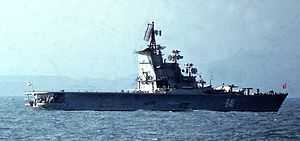Moskva-class helicopter carrier
 Leningrad underway in 1990. | |
| Class overview | |
|---|---|
| Name: | Moskva |
| Operators: |
|
| Succeeded by: | Kiev aircraft carriers |
| In service: | 1967-1991 |
| Planned: | 3 |
| Completed: | 2 |
| Cancelled: | 1 |
| Retired: | 2 |
| General characteristics | |
| Type: | helicopter carrier |
| Displacement: |
14,950 tons standard 17,500 tons full load |
| Length: | 189 m (620 ft) |
| Beam: | 23 m (75 ft) |
| Draught: | 13 m (43 ft) |
| Propulsion: | 2 shaft steam turbines, 4 pressure fire boilers, 100,000 hp |
| Speed: | 31 knots (57 km/h) |
| Range: | 14,000 nm at 12 knots (22 km/h) |
| Complement: | 850 |
| Armament: |
2× twin SA-N-3 'Goblet' SAM launchers |
| Aircraft carried: | 18× Kamov Ka-25 'Hormone' or Mi-8 helicopters |
| Notes: | Ships in class include: Moskva, Leningrad |
The Moskva class helicopter carriers were the first operational Soviet Navy aircraft carriers. The Soviet designation was Project 1123 Kondor.
These ships were laid down at Nikolayev South (Shipyard No.444). The lead vessel was launched in 1965 and named Moskva; she entered commission two years later. Moskva was followed by Leningrad, which was commissioned in late 1968; there were no further vessels built, reportedly due to the poor handling of the ships in rough seas. Both were conventionally powered.
The Moskvas were not true "aircraft carriers" in that they did not carry any fixed-wing aircraft; the air wing was composed entirely of helicopters. They were designed primarily as anti-submarine warfare (ASW) vessels, and her weapons and sensor suite was optimized against the nuclear submarine threat. Their strategic role was to defend the Soviet ballistic missile submarine bastions against incursions by Western attack submarines, forming the flagships of an ASW task force. [citation needed]
Design
The operational requirement was issued by Admiral Sergey Gorshkov in 1959. The aim of the ships was to counter NATO Polaris submarines and act as a flagship for anti-submarine warfare. Initially it was hoped to operate 10 helicopters from an 8000 ton ship. The design evolved into a larger vessel capable of operating up to 14 helicopters with self defence armament.
Armament
Shipboard ASW armament included a twin SUW-N-1 launcher capable of delivering a FRAS-1 projectile carrying a 450 mm torpedo (or a 5 kiloton nuclear warhead); a pair of RBU-6000 ASW mortars; and a set of torpedo tubes. For self-defence, the Moskvas had two twin SA-N-3 SAM launchers with reloads for a total of 48 surface-to-air missiles, along with two twin 57 mm/80 guns.
Sensors
- Radar
- Top Sail (air warning)
- Head Net
- 2 x Head Light (SAM guidance)
- 2 x Muff Comb (gun fire control)
- 2 x Don 2 (navigation)
- Sonar
- Moose Jaw (low frequency bow mounted)
- Mare Tail VDS
Propulsion
Gas turbines were considered but were as yet untried in such a large vessel. Instead a high pressure steam plant similar to that used by the Kynda-class cruisers was used. The machinery of the Moskva had severe problems and had to be rebuilt in 1973 following a fire. Operational performance was disappointing with a practical maximum speed of 30 knots and 24 knot maximum sustainable speed. Sea keeping was also disappointing.
Vessels


Both vessels were part of the Black Sea Fleet, and were retired in 1991. Both ships were scrapped in the late 1990s. A third ship to be named Kiev was cancelled in 1969, which was to have been an anti-surface warfare vessel. The Moskva class was succeeded by the Kiev class.
- Moskva,
- Laid down 15 December 1962,
- Launched 14 January 1965,
- Completed 25 December 1967
- Leningrad,
- Laid down 15 January 1965,
- Launched 31 July 1968,
- Completed 2 June 1969.
References
- Gardiner, Robert (ed.) (1995). Conway's all the World's Fighting Ships 1947-1995. London: Conway Maritime. ISBN 0-85177-605-1. OCLC 34284130. Also published as Gardiner, Robert; Chumbley, Stephen; Budzbon, Przemysław (1995). Conway's all the World's Fighting Ships 1947-1995. Annapolis, MD: Naval Institute Press. ISBN 1-55750-132-7. OCLC 34267261.
- Project 1123 Kondor - Moskva class, GlobalSecurity.org
- (Russian) Moskva class
| |||||||||||||||||||||||||||||||||||||||||